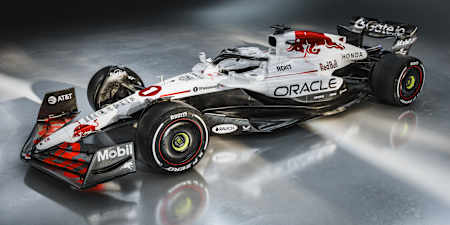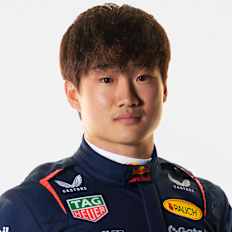
F1
Explore how these iconic F1 car liveries shaped teams, ignited fan loyalty and left their mark in the memory of the world's fastest motorsport.
Formula One cars make a statement in both the literal and figurative sense. It's not just the impressive, boundary-pushing engineering that captures the attention of fans around the world, it's also very much about how the cars look and feel as they fly around the track.
F1 liveries help fans identify cars on track at Grands Prix and events like the Red Bull Showrun as they zoom past at incredible speeds. But they go beyond that. Liveries drive team identity and deepen fan engagement – and the right design can even cement a car a place in F1 history, regardless of performance.
A brief history of F1 liveries
The F1 livery fans know today was not part of the sport during its earliest years. From its first days and into the 1960s, teams opted for simple designs and chose colors inspired by their home country. Italian cars were painted the bold Rosso Corso red and French cars were decked in the bleu de France. Great Britain was a notable exception. Since red, blue and white were already taken, British teams instead adopted a color that came to be known as British racing green.
By 1968, colors by country faded in favor of advertisements, known as Formula One Sponsorship Liveries. The first sponsored cars from companies like Marlboro and Gulf introduced new color schemes inspired by the brands, opening a door to new possibilities for all kinds of creativity. In fact, cigarette brand John Player Special was responsible for the iconic black and gold debuted with the Lotus 72 car, and advertisers kept up the creativity as new advancements in car design were introduced in the '80s. Recently, we've also seen the return of some classic colours, like British racing green on Aston Martin cars and silver paint on Mercedes cars.
Looking back across the history of Formula One, these are what we think are the top 10 liveries that'll be remembered as long as the sport lives.
01
Oracle Red Bull Racing RB21

Oracle Red Bull Racing's choice in livery for the 2025 Japanese GP pays tribute to engine partner Honda at their home race. To mark the final season of one of the most successful partnerships in the sport's history, Oracle Red Bull Racing will race in a special livery that's inspired by Honda’s RA272, which delivered the Japanese giant its first victory in the sport.
The 2025 season marks the 60th anniversary of Honda's first victory in Formula One and the design concept is a tribute to the RA272 that gave Honda its inaugural win at the 1965 Mexico Grand Prix, with American Richie Ginther at the wheel. The livery recreates the RA272’s iconic Japanese flag motif, featuring the 'H' logo on the nose and the simple Honda text on the rear of the bodywork. A special logo commemorating 60 years since Honda's first F1 victory will also be displayed across all four Red Bull cars on the grid
02
Renault R26
Driven by Fernando Alonso during his 2006 championship-winning season, the Renault R26 featured a striking blue and yellow design where Renault's famous yellow enveloped the front and the sides of the car, while the bright blue of cigarette company Mild Seven covered the rest of the body.
As for the car itself, the R26 model adopted a wider nose and left the red tip of the previous R25 behind. The Renault R26’s boldness mirrored Alonso's dominance from that year and secured Renault's second consecutive F1 title.
03
Red Bull Racing RB15
Red Bull Racing's first car with a Honda engine, the RB15 debuted in 2019 sporting a special one-time-only launch livery. The Aston Martin-sponsored team's deep blue car body was punctuated by the Red Bull logo in its instantly-recognisable red and yellow. The bold paint scheme and team colors embodied the cutting-edge performance and creativity of Red Bull Racing.
The car – driven by Max Verstappen, Pierre Gasly and Gasly’s mid-season replacement, Alexander Albon – made its debut at the Australian Grand Prix in Melbourne. Behind the wheel of the RB15, the team clinched crucial victories and podiums throughout the 2019 season.
“I was really excited to jump in the car. It felt good, we had no problems and the livery is very beautiful,” Verstappen said at the time.
The RB15 was also the first Honda-powered F1 car to win a race in 13 years, scoring three victories and six additional podium finishes across the season. It further made history by placing third in the Constructors' Championship, clinching two pole positions and five fastest-lap achievements.
04
Lotus 98T
The British Lotus 98T only won two races – the Spanish Grand Prix and the Detroit Grand Prix – but its color scheme is still one of the most well-remembered in F1 history. The John Player Special-sponsored car's deep black with shimmering gold accents became a fan favorite for its beauty.
The car debuted in 1986 and was notable for its performance despite the then-new restriction on fuel allotments. Driven by the late, great Ayrton Senna, the car finished fourth in that year's Constructors’ Championship, racking up four second-places, two thirds and eight pole positions.
05
McLaren MP4-23
The McLaren MP4-23 is famous for being the car Lewis Hamilton drove when he scored his first World Championship win at the 2008 Brazilian Grand Prix. But that's not the only reason it stands out, because its futuristic silver body won many compliments of its own. Striking red accents, representing sponsor Vodafone, were on the front, spoiler and sides of this car.
This car's build focused on improved aerodynamics in an attempt to dislodge Ferrari as the F1 world's leader. A higher nosecone, T-wings and a perfected wheelbase are among the fine-tooled features that got the McLaren MP4-23 to the finish line ahead of its rivals.
06
Scuderia Toro Rosso STR12
The Red Bull sponsorship of the Scuderia Toro Rosso STR12 is evident from its livery. The eye-catching metallic blue was accented by red, with the silver-winged bull emblazoned on the sides in multiple places. The blue was actually a shade lighter than the standard Red Bull shade, adding to the STR12’s impressive look. The upgraded livery was accompanied by coordinated drivers' helmets in a similarly-striking red and silver motif.
The smart use of the car body's space made this one of the most memorable F1 cars of its time, showing how livery can reflect team and brand evolution in one neat, bold package. Carlos Sainz finished seventh in the Constructors' Championship and fourth in the Singapore Grand Prix driving the Scuderia Toro Rosso STR12.

07
Jordan 191
The Jordan 191 is one of the most famous liveries in F1 history for many reasons. Not only was this stunning emerald and blue car the one in which Michael Schumacher made his F1 debut at the 1991 Belgian Grand Prix, but it also was the late Eddie Jordan's first F1 car as team owner. The deep green colour, inspired by sponsor 7Up's can, is considered to be among the most beautiful F1 cars of the era – and of all time.
08
Mercedes W10
Famous for dominating the 2019 season and for its looks, the Mercedes W10 made an impression on the track in every sense of the word. The black and silver paint scheme with vibrant shocks of teal and orange was a bold livery for the car's even bolder accomplishments on the track. With Lewis Hamilton and Valtteri Bottas at the wheel, the Mercedes W10 led the famed auto-maker to an impressive win percentage of 71.4 percent.
09
Ferrari F2004
Ferrari's F2004, driven by Michael Schumacher and Rubens Barrichello, was painted in the iconic Ferrari red, but what sets the F2004 apart is its sheer performance. The car won 15 out of 18 races in the 2004 season – the last title-conquering car during the Schumacher era.
The F2004 was built with a lower center of gravity and improved weight distribution, all while clocking in at a lower weight than prior models. The aerodynamics of the F2004 were unsurpassed and that showed in the car's impressive winning streak that season.
10
Red Bull Racing RB16B
The special 2021 livery debuted at the Turkish Grand Prix was a tribute to the Honda-Red Bull alliance. The cars driven by Max Verstappen and Sergio Pérez sported a clean white look inspired by the Honda RA272 and was chosen to honor the auto-maker’s first F1 win at the 1965 Mexican Grand Prix.
The design and branding impact of F1 liveries
Ever since F1 departed from country-specific hues, designs and colors have been directly influenced by the sponsor brands that finance the sport. Whether Red Bull’s dark blue, yellow and red, 7Up’s emerald green, or John Player Special’s black and gold, F1 is where ingenuity, engineering and creativity meet to the delight of fans the world over.
Iconic car designs are remembered for decades, and they become part of a team’s identity. Take Red Bull’s 2015 'Camobull' testing livery as an example. Daniel Ricciardo and Daniil Kvyat drove a car wrapped in a black-and-white camo design during pre-season testing, daring fans to find the bull among a herd of zebras. Though the car never made it to a race, the livery quickly gained momentum among fans and is a reminder of how changes to colors can be just as notable as new chassis designs or aerodynamic improvements.
Fans follow through with buying merchandise that matches the cars, too. For example, 1:8 scale models of the most iconic and beautiful F1 cars are hot collectors items and apparel and accessories often match the color schemes of the cars, too, so fans can wear their favorites wherever they go.
Liveries in Formula 1 transcend aesthetics – they're symbols of a team’s heritage, success and ambition. From Ferrari's classic red to unforgettably-bright neon yellow and one-off tributes that subvert fan expectations, these paint schemes are just as big a part of motorsport history as the vehicles themselves.












